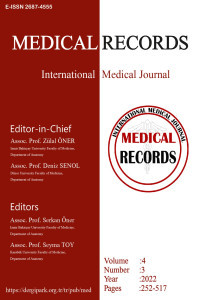Evaluation of Poisoning Cases Presenting to the Pediatric Emergency Department
Evaluation of Poisoning Cases Presenting to the Pediatric Emergency Department
poisoning, child, emergency room,
___
- 1. Özcan T, Tosun A, İnan G, et al. Hastanemize başvuran zehirlenme olgularının değerlendirilmesi. Adnan Menderes Üniversitesi Tıp Fakültesi Dergisi. 2002;3:5-8.
- 2. Gummin DD, Mowry JB, Beuhler MC, et al. 2020 Annual Report of the American Association of Poison Control Centers' National Poison Data System (NPDS): 38th Annual Report. Clinical Toxicol (Phila). ;59:1282-501.
- 3. Ulusal zehir danışma merkezi (UZEM) raporları 2014-2020 yılları yayınlandı. https://tatd.org.tr/toksikoloji/2021/10/21/ulusal-zehir-danisma-merkezi"https://tatd.org.tr/toxicology/2021/10/21/ulusal-zehir-danisma-merkezi access date 20.06.2022.
- 4. Uziel Y, Adler A, Aharonowitz G, et al. Unintentional childhood poisoning in the Sharon area in Israel: a prospective 5-year study. Pediatr Emerg Care. 2005;21:248-51.
- 5. İstatistiklerle çocuk. https://data.tuik.gov.tr/Bulten/Index?p=Istatistiklerle-Cocuk-2020-37228 access date: 20.06 2022.
- 6. National Vital Statistics System-Mortality Data via CDC. https://wonder.cdc.gov/controller/saved/D76/D266F092 access date: 20.06.2022
- 7. Yorulmaz A, Akbulut H, Yahya İ, et al. Retrospective evaluation of patients admitted to the pediatric emergency department with intoxication. Turkish Journal of Pediatric Emergency and Intensive Care Medicine. 2017;4:96-103.
- 8. Mintegi S, Fernandez A, Alutiza J, et al. Emergency visits for childhood poisoning: a 2-year prospective multicenter survey in Spain. Pediatr Emerg Care. 2006;22:334-8.
- 9. Akgül F, Er A, Çelik F, et al. Retrospective study of childhood poisonings. J Pediatr Emerg Intensive Care Med. 2016;3:91-6.
- 10. Ozdemir R, Bayrakci B, Tekşam O, et al. Thirty- three-year experience on childhood poisoning. Turk J Pediatr. 2012;54:251-9.
- 11. Andiran N, Sarikayalar F. Pattern of acute poisonings in childhood in Ankara: what has changed in twenty years? Turk J Pediatr. 2004;46:147-52.
- 12. Soyucen E, Aktan Y, Saral A, et al. Sakarya bölgesinde çocukluk çağı zehirlenmelerinin geriye dönük değerlendirilmesi. Çocuk Sağlığı ve Hastalıkları Dergisi. 2006;49:301-6.
- 13. PJ Caballero Valles, S Dorado Pombo, A Diaz Brasero A, et al. Epidemiologic survey of acute poisoning in the South area of the Community of Madrid: the VEIA 2004 study. An Med Interna. 2008;25:262-8.
- 14. Duyan Çamurdan A. Preventive cautions in childhood poisoning. Türkiye Klinikleri Pediatrik Bilimler. 2006;2:87-91.
- 15. Jepsen F, Ryan M. Poisoning in children. Current Paediatrics. 2005;15:563-8.
- 16. Akbay-Öntürk Y, Uçar B. Eskişehir bölgesinde çocukluk çağı zehirlenmelerinin retrospektif değerlendirilmesi. Çocuk Sağlığı ve Hastalıkları Dergisi. 2003;46:103-13.
- 17. Biçer S, Sezer S, Çetindağ F, et al. Evaluation of acute intoxications in pediatric emergency clinic in 2005 Marmara Medical Journal. 2007;20:12-20.
- 18. Türkmenoğlu Y, Akşahin B, Sarıtaş Ü, et al. Update glance on childhood intoxication. Okmeydanı Medical Journal. 2015;31:82-91.
- 19. Yılmaz HL, Derme T, Yıldıztaş D, Alhan E. Evaluation of childhood intoxication cases in Çukurova region. Nobel Medicus. 2009;5:35-44.
- 20. Akıcı N, Bayoğlu D, Gürbüz T, et al. Investigation of Poisonings in Children aged six and under and in children older than six years. Marmara Pharm J. 2013;17:35-41.
- 21. Özdemir D, Yiş U, Kalkan Ş, et al. Akut çocukluk çağı zehirlenmeleri. Eurasian Emerg Med. 2003;1:36-8.
- 22. Even KM, Armsby CC, Batema ST. Poisoning requiring admission to the pediatric intensive care unit: a 5-year review. Clin Toxicol (Phila). 2014;52:519-24.
- 23. Genç G, Saraç A, Ertan Ü. Çocuk hastanesi acil servisine başvuran zehirlenme olgularının değerlendirilmesi. Nobel Med. 2007;3:18-22. 24. Kondolot M, Akyıldız B, Görözen F, et al. Çocuk acil servisine getirilen zehirlenme olgularının değerlendirilmesi. Çocuk Sağlığı Ve Hast Derg. 2009;52:68-74.
- Yayın Aralığı: Yılda 3 Sayı
- Başlangıç: 2019
- Yayıncı: Zülal ÖNER
Anıl ALTIPARMAK, Muhammed Furkan ARPACI, Merve AYDIN, Feyza İNCEOĞLU, Hıdır PEKMEZ
Invention Arising From Surgical Service Needs; Stoma Bag Cover
Betul GUZELYUZ, Server Sezgin ULUDAĞ
Fadime BEYAZYÜZ, Elif GÜLBAHÇE MUTLU, Serife ALPA, Fatma Zehra ERBAYRAM, Fatma Nur TÜRKOĞLU, Şemsettin KULAÇ
Prediction of Short or Long Length of Stay COVID-19 by Machine Learning
Muhammet ÖZBİLEN, Zübeyir CEBECİ, Aydın KORKMAZ, Yasemin KAYA, Kaan ERBAKAN
Did the COVID-19 Pandemic Period Increased Suicide Attempts in Society?
Lomber Disk Hernili Hastalarda Q açısı ve Hamstring Uzunluğunun Denge Performansına Etkisi
The Use of Botulinum Toxin in Temporomandibular Disorders: A Bibliometric Study
Serkan YILDIZ, Feridun ABAY, S. Kutalmış BÜYÜK
Hasan Esat YÜCEL, Tufan ULCAY, Ozkan GORGULU, Kağan TUR, Muhammed Hüseyin KIRINDI, Elif ÇÖMLEKÇİ, Emre UĞUZ, Berat YAĞMUR, Burcu KAMAŞAK, Ahmet UZUN
Mahmut Zabit KARA, Mehmet Hamdi ÖRÜM, Ayşe Sevgi KARADAĞ, Aysun KALENDEROĞLU
Tuba OZCAN METİN, Gulsen BAYRAK, Selma YAMAN, Adem DOĞANER, Atila YOLDAŞ, Nadire ESER, Duygun ALTINTAŞ AYKAN, Banu YILMAZ, Akif Hakan KURT, Mehmet ŞAHİN, Gulsah GURBUZ
